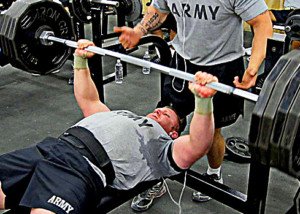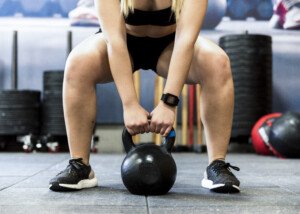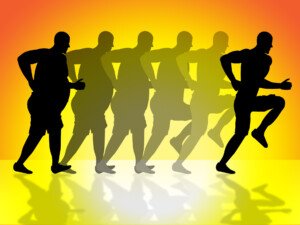
You need only three strength training exercises to drop 100 pounds of unhealthy body fat.
There’s nothing gimmicky about what I’m going to tell you. If you’re a hundred pounds overweight, or weigh 450 pounds (think of losing 100 pounds three times), you can lose 100 pounds with the following three exercises, PLUS a controlled, clean diet:
Deadlift
Squat
Bench press
If you were to employ only these exercises and nothing else as far as structured exercise, I’d recommend a three-times-a-week regimen, such as Mon/Wed/Fri or Tues/Thurs/Sat.
All the muscles in your body will get trained with the deadlift, squat and bench press.
These three exercises emphasize large muscle groups, though the small ones like biceps and triceps DO get worked. So do the abs!
To lose 100 pounds with these three exercises, follow this formula:
1) Do five sets of each for all three training days.
2) Take one minute of rest (no longer) between sets, and 2-3 minutes in between exercises.
3) Set the resistance so that it’s possible to do eight repetitions but impossible to do more than 12. If you can do more than 12, increase the resistance. If you can only do seven reps, decrease.
Point 3 is tricky because it will be impossible to take only one minute of rest and keep pumping out an 8-12 rep max using the SAME weight load.
For example, suppose your first bench press set is 11 reps for 95 pounds; you absolutely cannot do any more.
Rest one minute. Your second set at 95 pounds might be eight or nine, but it’s more likely you’ll only be able to do seven reps.
This falls out of the eight to 12 range. In anticipation of this, you’d have to quickly reset the barbell to a lighter weight before the minute was up.
It’s easier to do this if the 95 pounds are loaded with two 10-pound plates and a five-pounder on each side, rather than a 25-pounder on each side (when using a standard Olympic bar which weighs 45 pounds).
Because then you can just slip off the five-pound plates to lighten the barbell; you’ll be able to press 85 pounds within that 8-12 rep range.
If you take off TOO much weight, you’ll feel like you can go beyond 12 reps.
What Exactly Are the Deadlift, Squat and Bench Press? They Are Shown Below

Preparing for the deadlift. Freepik.com
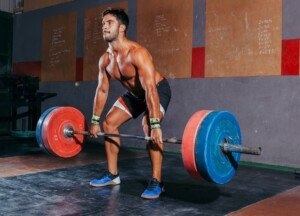
Midpoint of the deadlift. Freepik.com
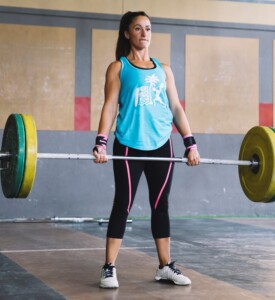
Completion of the deadlift. Freepik.com
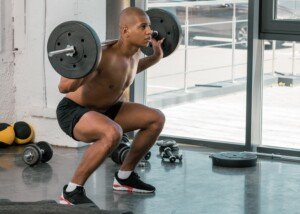
Squat. Depositphotos.com
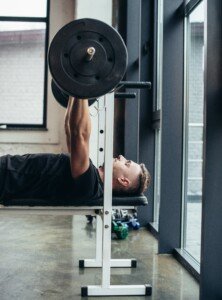
Bench press. Depositphotos.com
Why is the 8-12 rep range so important for losing 100 pounds?
It’s time under tension. If you don’t do enough reps, the muscle cells won’t be subjected to a long enough tension.
When enough tension is imposed on them, they are forced to develop “metabolic machinery.”
The acquisition of this machinery within each muscle cell, and the sustenance of it, requires energy. This energy is pulled from stored body fat.
If the time under tension goes for too long (more than 12 reps), the focus will be on fewer fast twitch muscle fibers and more on slow twitch.
Slow twitch is designed for endurance. If you can do more than 12 reps, the weight is too light to incite optimal acquisition of metabolic machinery.
If you must struggle to get within the 8-12 range, the weight is heavy enough to maximize metabolic machinery.
This doesn’t mean that a few sets here and there can’t be a 6-7 rep max or 13-14 rep max.
There will be times you’ll mis-judge how much to reduce the resistance, for example, and you’ll find yourself barely getting in six reps, or finding that 12 weren’t all that hard. It’s okay to periodically make this miscalculation.
But the general protocol is the 8-12 rep max to build up that metabolic machinery which will accelerate your resting metabolism.
Furthermore, the one-minute rests will amplify this effect. Longer rests will take you further out of range, and your muscle cells will develop more contractile proteins rather than metabolic machinery.
If the shift is on contractile proteins, you’ll get stronger faster; there’s less development of the metabolic innards and instead, an increase in contractile proteins.
Enough of the science—just trust me: Do the deadlift, squat and bench press, as I’ve described, and you’ll lose 100 pounds (as long as you eat sensibly—no gorging on pizza after your workouts).
Morbidly obese people will have a challenge learning the back squat (free barbell across back), so I recommend using the Smith machine until you lose enough weight to begin learning the free barbell squat. The goal is to hit parallel with excellent form!
The deadlift is easier for a morbidly obese individual to learn, but this exercise demands flawless form.
The bench press is the easiest because you lie on a bench, but for best results and safety, you should use good form.
You can lose 100 pounds with these three exercises by following the protocol described in this article.

